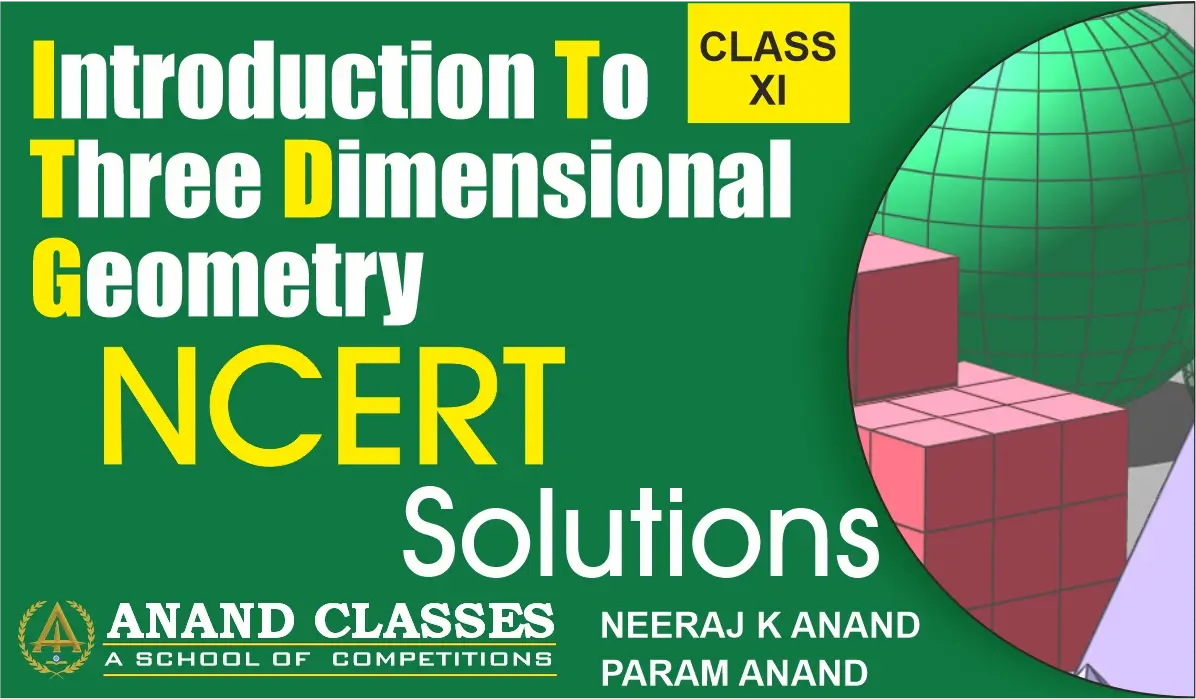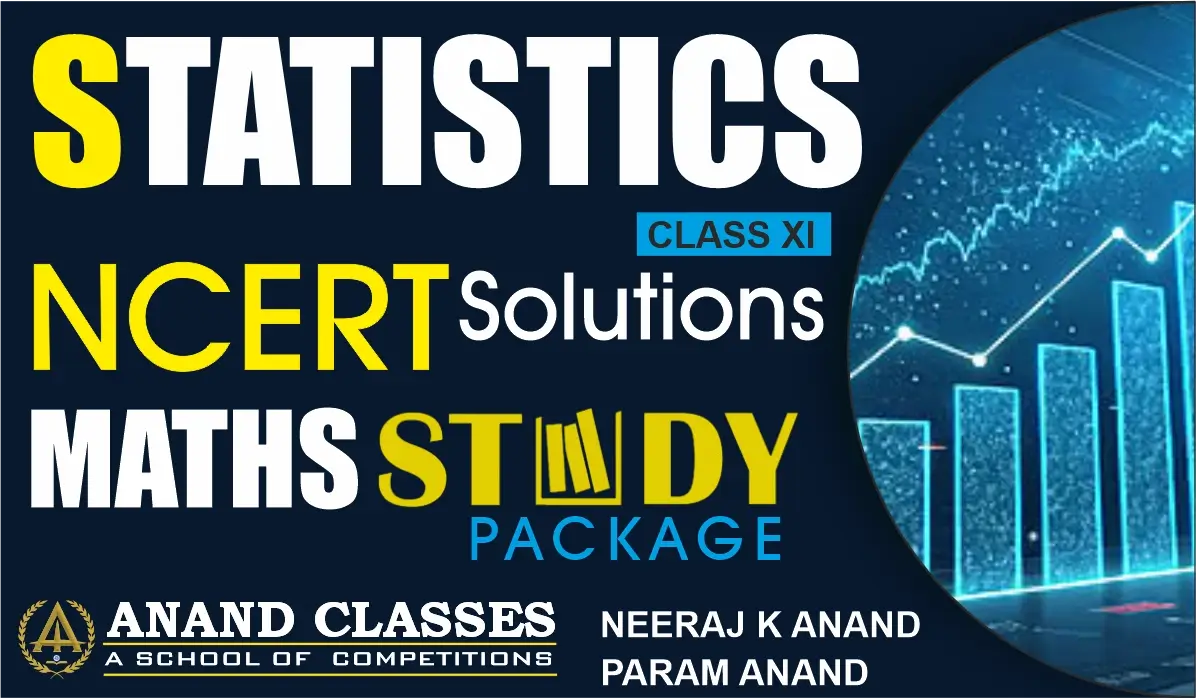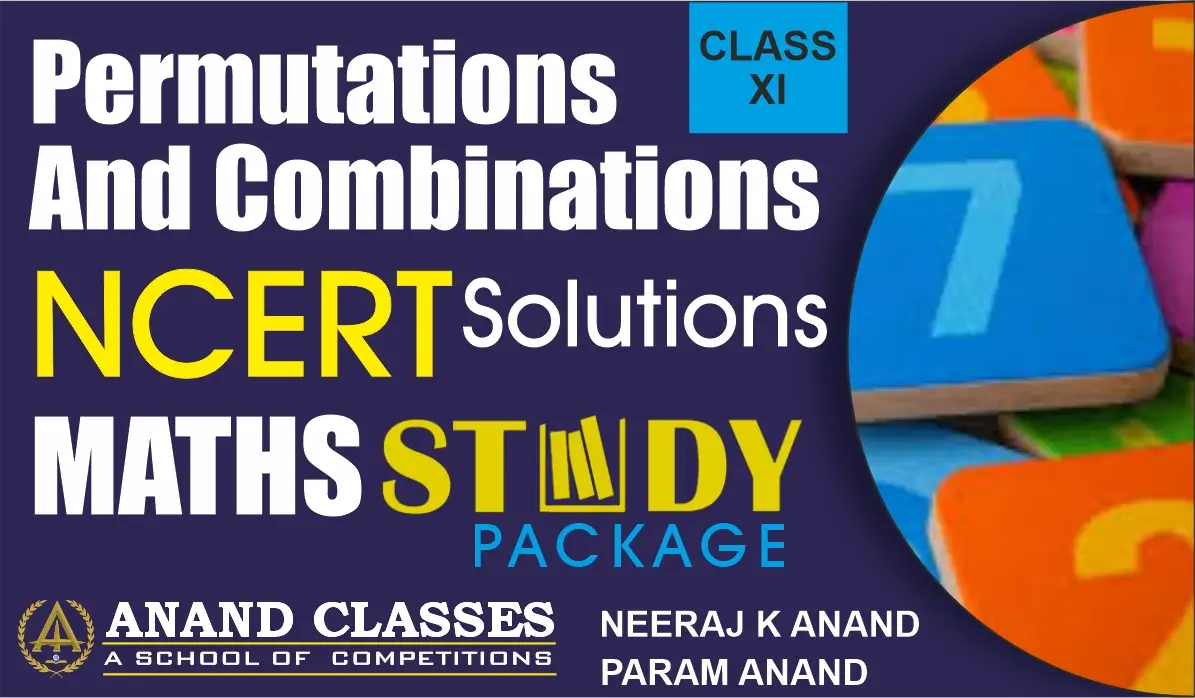Anand Classes offers comprehensive NCERT Solutions for Class 11 Maths Chapter 11 Introduction to Three Dimensional Geometry Miscellaneous Exercise, designed to help students practice advanced problems based on distance formula, section formula, and coordinates in 3D space. These step-by-step solutions strictly follow the latest CBSE and NCERT guidelines, making them ideal for exam preparation and concept revision. Each question is solved clearly to build a strong foundation in three-dimensional geometry. Click the print button to download study material and notes.
NCERT Question 1 : Three vertices of a parallelogram $ABCD$ are $A(3, -1, 2)$, $B(1, 2, -4)$, and $C(-1, 1, 2)$. Find the coordinates of the fourth vertex.
Solution:
$ABCD$ is a parallelogram with vertices $A(3, -1, 2)$, $B(1, 2, -4)$, $C(-1, 1, 2)$ and $D(x, y, z)$.
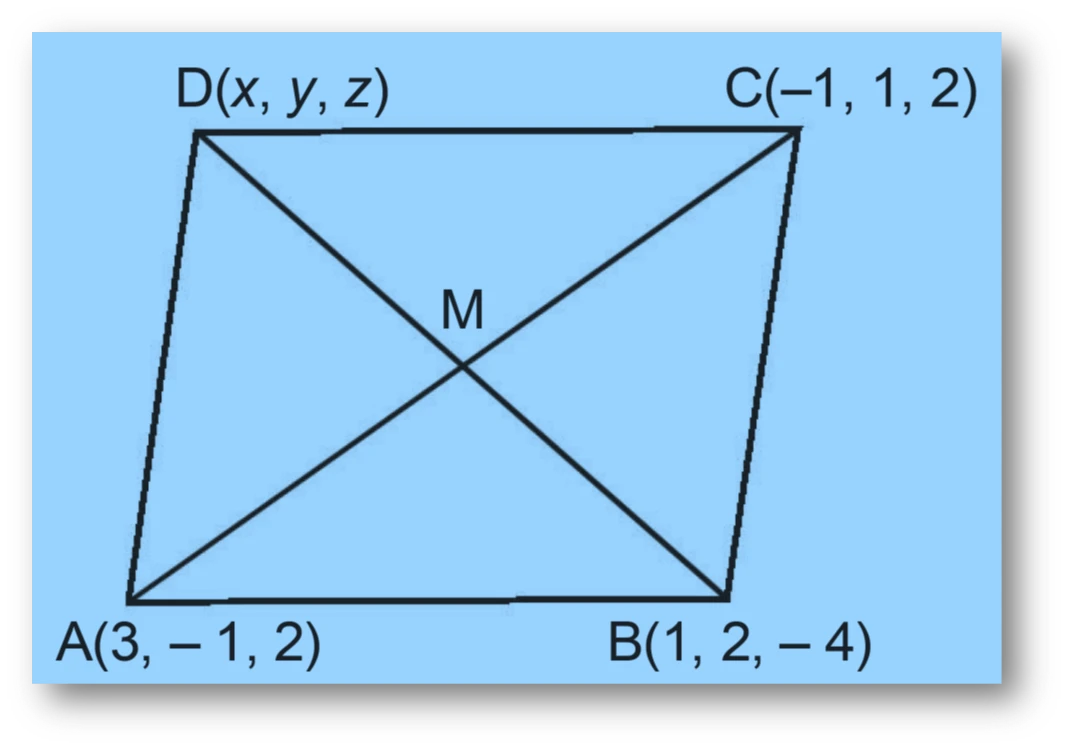
The diagonals of a parallelogram bisect each other at point M..
Hence,
$$\text{Midpoint of } AC = \text{Midpoint of } BD = \text{Point } M$$
Now, by using the midpoint (section) formula:
$$
M(x, y, z) = \left( \frac{x_1 + x_2}{2}, \frac{y_1 + y_2}{2}, \frac{z_1 + z_2}{2} \right)
$$
For $AC$,
$$
M = \left( \frac{3 + (-1)}{2}, \frac{-1 + 1}{2}, \frac{2 + 2}{2} \right)
$$
$$
M = \left( \frac{2}{2}, 0, \frac{4}{2} \right) = (1, 0, 2) \quad \text{…(1)}
$$
For $BD$,
$$
M = \left( \frac{1 + x}{2}, \frac{2 + y}{2}, \frac{-4 + z}{2} \right) \quad \text{…(2)}
$$
Now, equating (1) and (2):
$$
\frac{1 + x}{2} = 1, \quad \frac{2 + y}{2} = 0, \quad \frac{-4 + z}{2} = 2
$$
Solving each equation:
$$
1 + x = 2 \Rightarrow x = 1
$$
$$
2 + y = 0 \Rightarrow y = -2
$$
$$
-4 + z = 4 \Rightarrow z = 8
$$
Hence, the coordinates of the fourth vertex are
$$D(1, -2, 8)$$
Coordinate geometry problem using midpoint formula — important for Class 11, JEE Main, and NDA preparation with Anand Classes.
NCERT Question 2 : Find the lengths of the medians of the triangle with vertices A(0,0,6), B(0,4,0), and C(6,0,0).
Solution :
The vertices of the triangle are A(0,0,6), B(0,4,0) and C(6,0,0).
So, let the medians be AD, BE and CF corresponding to the vertices A, B and C respectively.
D, E and F are the midpoints of the sides BC, AC and AB respectively.
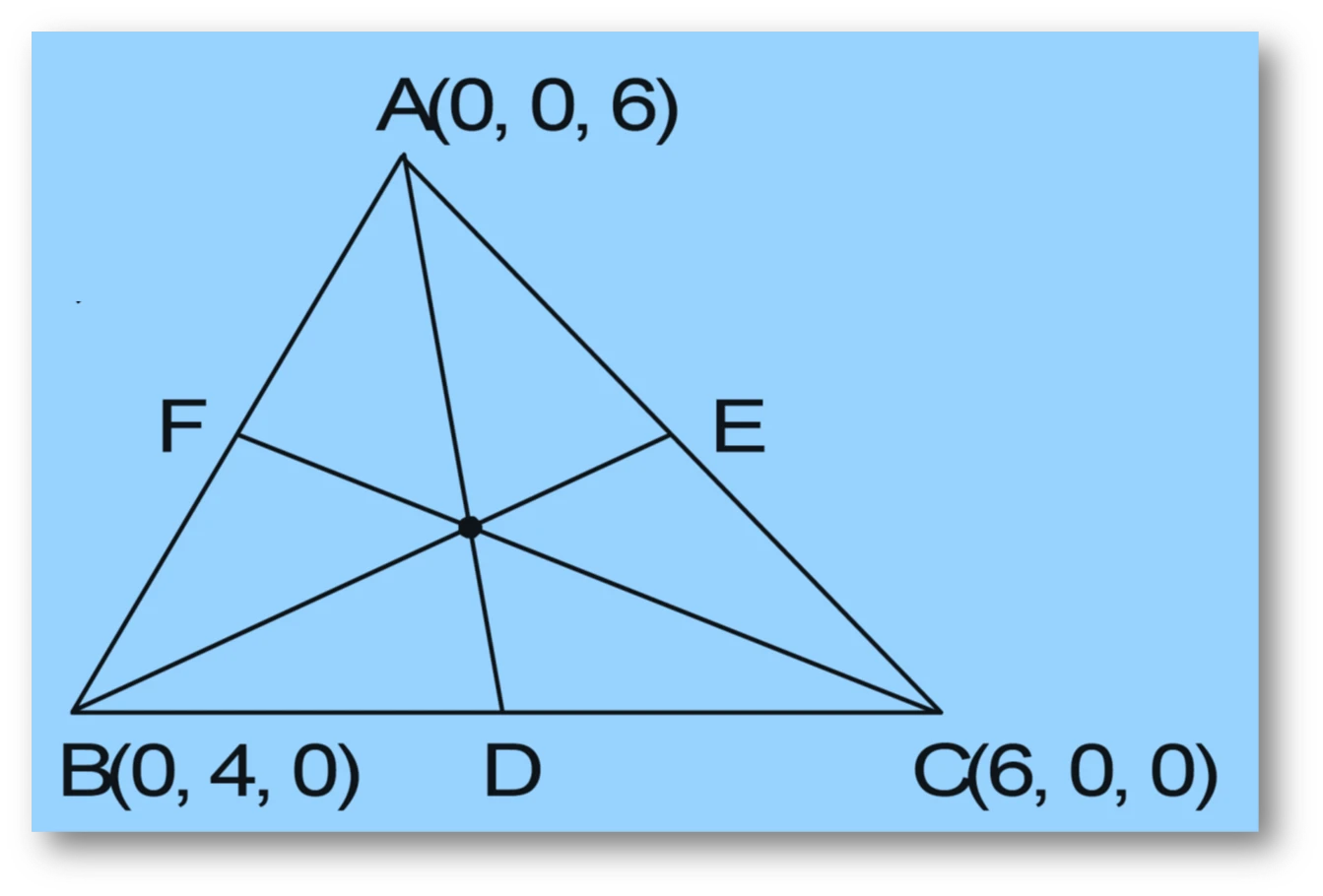
Coordinates of midpoint for the line segment joining $(x_1,y_1,z_1)$ and $(x_2,y_2,z_2)$ are
$$
\left(\frac{x_1+x_2}{2}, \frac{y_1+y_2}{2}, \frac{z_1+z_2}{2}\right).
$$
So, coordinates of D (midpoint of BC) are
$$
D=\left(\frac{0+6}{2},\frac{4+0}{2},\frac{0+0}{2}\right)=(3,2,0).
$$
Coordinates of E (midpoint of AC) are
$$
E=\left(\frac{0+6}{2},\frac{0+0}{2},\frac{6+0}{2}\right)=(3,0,3).
$$
Coordinates of F (midpoint of AB) are
$$
F=\left(\frac{0+0}{2},\frac{0+4}{2},\frac{6+0}{2}\right)=(0,2,3).
$$
By using the distance formula for two points $P(x_1,y_1,z_1)$ and $Q(x_2,y_2,z_2)$,
$$
PQ=\sqrt{(x_1-x_2)^2+(y_1-y_2)^2+(z_1-z_2)^2}.
$$
Length of Median (AD)
$$
AD=\sqrt{(0-3)^2+(0-2)^2+(6-0)^2}
=\sqrt{9+4+36}=\sqrt{49}=7.
$$
Length of Median (BE)
$$
BE=\sqrt{(0-3)^2+(4-0)^2+(0-3)^2}
=\sqrt{9+16+9}=\sqrt{34}.
$$
Length of Median (CF)
$$
CF=\sqrt{(6-0)^2+(0-2)^2+(0-3)^2}
=\sqrt{36+4+9}=\sqrt{49}=7.
$$
Answer: The lengths of the medians are $(AD=7, BE=\sqrt{34}, CF=7)$.
Great practice for using midpoint and distance formula in three dimensions — useful for Class 11 coordinate geometry, JEE Main practice, and solidifying 3D vector intuition.
NCERT Question 3 : If the origin is the centroid of the triangle $PQR$ with vertices $P(2a, 2, 6)$, $Q(-4, 3b, -10)$, and $R(8, 14, 2c)$, then find the values of $a, b,$ and $c$.
Solution :
The vertices of the triangle are $P(2a, 2, 6)$, $Q(-4, 3b, -10)$, and $R(8, 14, 2c)$.
Coordinates of the centroid $(0, 0, 0)$ of a triangle having vertices $(x_1, y_1, z_1)$, $(x_2, y_2, z_2)$, and $(x_3, y_3, z_3)$ are given by
$$
\left( \frac{x_1 + x_2 + x_3}{3}, \frac{y_1 + y_2 + y_3}{3}, \frac{z_1 + z_2 + z_3}{3} \right)
$$
Substituting the coordinates of $P$, $Q$, and $R$, we get
$$
(0, 0, 0) = \left( \frac{2a – 4 + 8}{3}, \frac{2 + 3b + 14}{3}, \frac{6 – 10 + 2c}{3} \right)
$$
Simplifying each component:
$$
(0, 0, 0) = \left( \frac{2a + 4}{3}, \frac{3b + 16}{3}, \frac{2c – 4}{3} \right)
$$
Now, equating each coordinate:
$$
\frac{2a + 4}{3} = 0 \Rightarrow 2a + 4 = 0 \Rightarrow a = -2
$$
$$
\frac{3b + 16}{3} = 0 \Rightarrow 3b + 16 = 0 \Rightarrow b = -\frac{16}{3}
$$
$$
\frac{2c – 4}{3} = 0 \Rightarrow 2c – 4 = 0 \Rightarrow c = 2
$$
Final Answer:
$$
a = -2, \quad b = -\frac{16}{3}, \quad c = 2
$$
Mastering centroid formulas in 3D coordinate geometry strengthens understanding for Class 11 Maths, JEE Main, and NDA exams — especially when solving problems involving coordinates and section formulas.
NCERT Question 4 : If $A$ and $B$ be the points $(3, 4, 5)$ and $(-1, 3, -7)$ respectively, find the equation of the set of points $P$ such that $PA^2 + PB^2 = k^2$, where $k$ is a constant.
Solution :
The points $A (3, 4, 5)$ and $B (-1, 3, -7)$
Let $P(x, y, z)$.
Now, by using the distance formula:
$$
\text{Distance between two points } (x_1, y_1, z_1) \text{ and } (x_2, y_2, z_2) $$ $$= \sqrt{(x_1 – x_2)^2 + (y_1 – y_2)^2 + (z_1 – z_2)^2}
$$
So,
$$
PA = \sqrt{(3 – x)^2 + (4 – y)^2 + (5 – z)^2}
$$
and
$$
PB = \sqrt{(-1 – x)^2 + (3 – y)^2 + (-7 – z)^2}
$$
Given that $PA^2 + PB^2 = k^2$, we have:
$$
[(3 – x)^2 + (4 – y)^2 + (5 – z)^2] + [(-1 – x)^2 + (3 – y)^2 + (-7 – z)^2]= k^2
$$
Expanding and simplifying,
$$
[(9 + x^2 – 6x) + (16 + y^2 – 8y) + (25 + z^2 – 10z)] $$ $$+ [(1 + x^2 + 2x) + (9 + y^2 – 6y) + (49 + z^2 + 14z)] = k^2
$$
Combining like terms,
$$
2x^2 + 2y^2 + 2z^2 – 4x – 14y + 4z + 109 = k^2
$$
Rearranging,
$$
2(x^2 + y^2 + z^2 – 2x – 7y + 2z) = k^2 – 109
$$
Dividing both sides by 2,
$$
x^2 + y^2 + z^2 – 2x – 7y + 2z = \frac{k^2 – 109}{2}
$$
Hence, the required equation is
$$
\boxed{x^2 + y^2 + z^2 – 2x – 7y + 2z = \frac{k^2 – 109}{2}}
$$
This equation represents the locus of all points $P(x, y, z)$ that satisfy $PA^2 + PB^2 = k^2$.
Understanding such 3D locus equations is vital for mastering coordinate geometry concepts for Class 11 Maths, JEE Main, and NDA exams.
